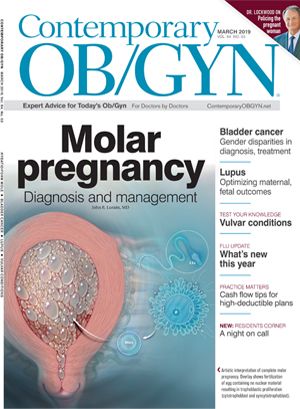Vesicovaginal fistula after laparoscopic hysterectomy
Patient communication and preoperative consent are the main issues in this case.
©Feng Yu/shutterstock.com

Learning Points

Preoperative events
A 40-year-old G3P3003 in for her annual exam complained of heavy, painful periods, which had previously failed to respond to treatment with cyclical progestins. She requested a hysterectomy. Her exam revealed a moderately enlarged uterus. Her weight was 250 lb, with a body mass index of 42.9 kg/m2. Ultrasound revealed a 12.3 x 5.0 x 7.03-cm uterus, 1.9 x 1.6 x 1.9-cm fibroid, and 18-mm endometrium. The woman’s left ovary had an exophytic area, thought to be a paraovarian cyst.
Five weeks later, the patient returned for a consultation about treatment. In addition to hysterectomy, the physician discussed uterine artery embolization (UAE), leuprolide acetate, and myomectomy. The patient chose a hysterectomy. The preoperative consent had the “standard” risks of surgery, including damage to surrounding tissues, and listed the discussed alternatives to surgery. Pertinent preoperative labs revealed hemoglobin and hematocrit (H/H) 12.4 g/dL and 41.2%, respectively, and random blood glucose 173 mg/dL. Blood urea nitrogen (BUN) and creatinine (Cr) levels were normal. Urinalysis (UA) showed trace bacteria.
Hospitalization
Six days after the preoperative appointment, the patient underwent laparoscopic hysterectomy with bilateral salpingo-oophorectomy (BSO). A uterine manipulator with a paracervical ring was used for uterine manipulation. A bipolar sealing device was used for salpingo-oophorectomy and management of the uterine arteries. A circumferential vaginal incision was made with an L-shaped electrosurgical hook. The cuff was closed vaginally, as the laparoscopic needle drivers were broken. No evidence of bleeding or bladder injury or leakage was found on laparoscopy after cuff closure. A vaginal pack was placed postoperatively. Cystoscopy was not performed. The operating time was 96 minutes, with 75 cc of blood loss.
While in the postoperative area, the patient was noted to have blood-tinged urine that cleared within 30 minutes. On postoperative Day 1, she was doing well, with 2000 mL of urine output after surgery and a stable blood count. The vaginal pack was removed, and she was discharged. Pathology revealed a 231-g uterus, with mild chronic endocervicitis, proliferative endometrium, and adenomyosis. Both ovaries were normal with a hydatid cyst of Morgagni.
Readmission
Three days later the patient was readmitted with an ileus, dehydration, and acute renal failure. She had tachycardia (119-131 bpm), a distended abdomen, and rare bowel sounds. An abdominal x-ray revealed an ileus.
Admission labs revealed the following:
- BUN 37.0 mg/dL (7-18 mg/dL);
- Cr 3.39 mg/dL (0.8-1.30 mg/dL)
- BUN/Cr ratio 11 (12-18)
- Glucose 330 mg/dL (70-99 mg/dL)
- White blood cell (WBC) count 16,600 cells/mcL (4000 -11,900)
- H/H 12.8 g/dL/40.2%
- UA 3+ protein; red blood cell (RBC) count 25-50 per high-power field (HPF); WBC: 50-100 per HPF
The patient was treated with rehydration and an oral gastric tube. A Foley catheter was placed with the recorded urine output: 0009 = 800 cc; 0809 = 800 cc; 24 hours = 1600 cc. The next day her BUN was 22 mg/dL and Cr 1.41 mg/dL. The patient’s primary care physician (PCP) was consulted on Hospital Day 1. He documented that the patient began eating and was tolerating a normal diet and voiding normally. He confirmed that dehydration led to the increased BUN and Cr. A discrepancy was found in two notes: the PCP documented, “She has not had dysuria, hesitancy, or frequency.” A nurse documented, “Loss of bladder control. Started October 17 [2 days post-operatively].” On Hospital Day 2 of the readmission there was leaking around the Foley catheter. It was replaced with clear urine returned. An intravenous pyelogram (IVP) had been ordered on admission but was cancelled with a note about the elevated Cr. The patient improved clinically with normalization of her BUN and Cr. She was discharged on Hospital Day 4.
Follow-up
Eleven days postoperatively (6 days after rehospitalization) the patient was seen with complaints of urinary urgency and some difficulty controlling her urine. UA revealed 2+ leukocytes and was positive for nitrites. The patient was diagnosed with a urinary tract infection (UTI) and urgency and treated with sulfamethoxazole/trimethoprim and tolterodine.
On evaluation 1 week later, she was unable to control her urine. Entertaining the possibility of a vesicovaginal fistula (VVF), the gynecologist referred the patient to a urologist. She patient was seen 12 days later (18 days after surgery). The urologist documented, “Urinary incontinence since her surgery.” Exam revealed a cystocele and a rectocele, with no obvious fistula. UA revealed
2+ leukocytes. An IVP revealed delayed extrusion of contrast into the vagina. On cystoscopy approximately 5 weeks after the initial surgery, the urologist found a dime-sized eschar, with fluid entering the vagina. A large eschar was found in the vagina, near the cuff. The patient was referred to a university hospital for management of VVF.
VVF repair
The patient was seen 3 months later (4 months after the original surgery) by the university urologist, who confirmed presence of a 10-mm VVF. Approximately 4 weeks later, the patient underwent laparotomy, cystotomy, and excision of VVF, approximately 1.5 cm from the right ureter. Pathology revealed fibrosis and chronic inflammation. Areas of marked chronic inflammation with extensive granulomatous inflammation with foreign body type giant cells were identified. The patient had an uncomplicated postoperative course and, after passing a voiding trial, had her indwelling catheter removed.
The trial
A suit was filed claiming:
- Failure to communicate treatment options to patient
- Failure to perform diagnostic tests
- Failure to perform surgery within the standard of care (SOC)
- Failure to detect bladder injury at surgery
- Failure to provide adequate postoperative care
- Premature discharge from hospital
The plaintiff’s expert was critical of the preoperative work-up, specifically lack of an endometrial biopsy or hysteroscopy for abnormal uterine bleeding (AUB), particularly noting the patient’s increased risk of endometrial hyperplasia or cancer due to morbid obesity. The expert also stated that magnetic resonance imaging should have been performed to diagnose adenomyosis, which he felt was the primary cause of the patient’s AUB. He testified that a hysterectomy should not have been the recommended option. Rather, less invasive approaches, such as endometrial ablation or UAE, should have been performed, eliminating risk of VVF. Further, the patient should have had better glucose control, as her preoperative glucose (random = 170 mg/dL) placed her at greater risk of poor wound healing. He expressed no concerns about the surgical technique or a breach of the SOC from the time of original postsurgical discharge until she was readmitted. He stated the ileus was a result of urine leakage into the peritoneal cavity. He admitted that bladder spasms are a known transient phenomenon after a hysterectomy. He testified that there was a thermal injury to the bladder, worsened by poor glucose control. However, he could not state that a fistula would not have developed if the patient’s elevated blood sugar had been aggressively treated.
The plaintiff testified that she had not requested a hysterectomy. However, the defense attorney countered with the patient-completed intake form that stated her reason for the original gynecologic visit was, “Annual exam and talk about hyst.” The patient also testified that she leaked all over herself beginning the day after surgery, not substantiated by chart documents.
The defendant testified the patient desired hysterectomy and removal of both ovaries. He discussed treatment options on two separate office visits prior to surgery, further discussing hormone replacement following hysterectomy and BSO. The defendant admitted he did not have cystoscopy privileges.
The defense expert testified that although it was appropriate to discuss endometrial ablation and UAD with patients, it is not necessary to encourage their use. Hysterectomy is within the SOC for definitive therapy for menorrhagia. The expert stated that the patient was not a suitable candidate for endometrial ablation, due to the her adenomyosis and relatively young age, which both predisposed to treatment failure. Further, the woman’s morbid obesity placed her at risk for endometrial hyperplasia and cancer. Although endometrial sampling is recommended prior to surgery for AUB, this oversight had no impact on the ultimate outcome.
The defense expert testified that the procedure described in the operating notes comported with the SOC. Although cystoscopy was not performed, it is acknowledged that some hospitals, as in this case, do not grant general gynecologists cystoscopy privileges. The expert stated that the postoperative care rendered was
appropriate, as was discharge timing. This expert testified that there was no substantiated evidence that a random glucose < 200 mg/dL leads to poor surgical healing.
The defense expert stated that the care rendered during the patient’s initial rehospitalization was appropriate, with timely diagnostic procedures and consultations. With an elevated Cr, it was appropriate to cancel the ordered IVP. With rehydration, rapid resolution of the elevated BUN and Cr did not support a ureteral injury or peritoneal accumulation of urine. Outflow of clear urine from the Foley catheter did not support presence of a VVF. Further, even if a fistula had been diagnosed at that time, treatment would have been postponed.
At her initial postoperative office visit, the defendant reasonably diagnosed bladder control issues due to bladder spasms and a UTI, with appropriate treatment rendered. At the subsequent visit he appropriately considered a VVF and referred the patient appropriately to urology for further evaluation and treatment, with appropriate care rendered.
The verdict: With less than an hour’s deliberation, the jury rendered a defense verdict.
Importance of reproductive health services for adolescents during the COVID-19 pandemic
October 30th 2024In a recent study, high rates of reproductive health service use were reported among adolescent mothers, indicating the benefits of this model for providing care when other options are unavailable.
Read More
Increasing ondansetron use reported against NVP in the United States
October 29th 2024Despite being recommended as a third-line therapy, rates of ondansetron use to treat nausea and vomiting in pregnancy have increased, making it the most common prescription antiemetic against this condition in the United States.
Read More
Study finds high rates of incidental MRI findings in endometriosis cases
October 29th 2024A recent study highlights the frequent occurrence of incidental findings on pelvic magnetic resonance imaging for endometriosis, emphasizing the need for radiologists to focus on those with higher clinical significance.
Read More

